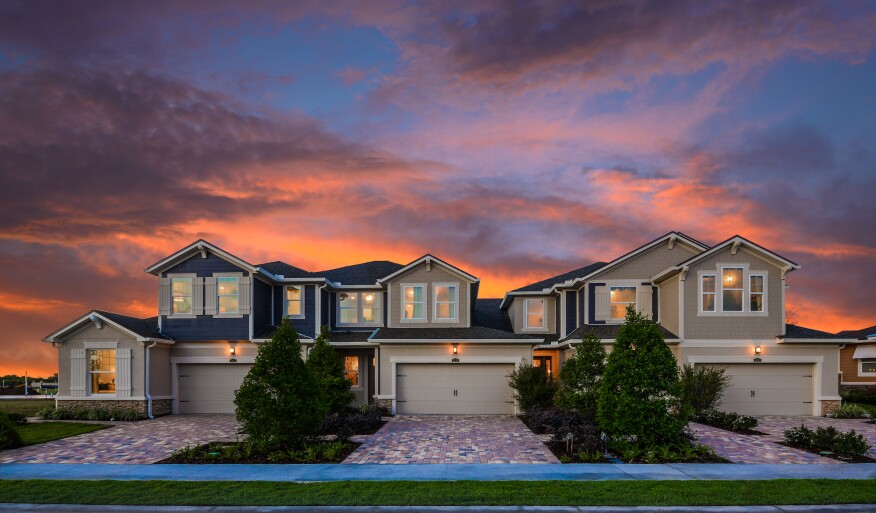
Townhome construction has surged in the last year or so. By the most recent numbers, townhomes now make up nearly 13% of all single-family starts and have notched a 38% uptick in just a single year.
And if you ask most experts, that trend will only continue as 2022 goes on.
As NAHB chief economist Rob Dietz explains, “NAHB expects the construction of townhouses to rise from 13% to higher than 15% of all single-family homes in the coming years.”
If that forecast rings true, it will mark a record for townhome construction, surpassing its previous 2008 peak of 14.6%.
It sounds like a bold prediction, but the conditions are ripe for townhomes to thrive. Scott Hawley, managing director at Kaplan Residential, expects similar numbers by as early as this year.
“It is no secret townhome construction had its most successful year in 2021, and I would not be surprised if 2022 beats last year’s metrics,” says Hawley, whose company pivoted to build-to-rent townhomes about five years ago. “Others are catching on.“
The Impact of Rising Prices
Hawley’s right: Other builders are definitely hopping on the bandwagon—and for good reason. For one, townhomes just offer more bang for a builder’s buck, especially with high lumber, material prices, and inflation to worry about.
“Many builders are turning to this product, as the price point for sale is lower, and it allows them to build more units,” says Brian Lawrence, who’s seen an uptick in townhome financing applications in his work as vice president and relationship manager at Univest Bank and Trust Co. “Profit on the project increases with increased density.”
The ability to get townhomes up and running faster than other rental housing options is an important factor, too.
“Rental townhouses start to cash in much faster than traditional apartments, making them less risky,” Hawley says. “During construction of a rental townhouse community, the property management company is able to start leasing a row of five units as soon as that row receives its certificate of occupancy (CO). This is very different from conventional apartments where the property management company has to wait for a CO on a 100-unit building to start leasing. ”
Finally, there are market conditions to think about—particularly the skyrocketing prices of traditional, detached single-family homes.
According to Realtor.com, the median home price ended 2021 at $375,000—up a whopping 25% since 2019. These higher prices, coupled with rising mortgage rates, eat into affordability and push many buyers out of the market. Townhomes can often be the perfect, lower-cost alternative for those sidelined consumers.
“Prices of homes have increased across the board,” Lawrence says. “Townhomes are becoming the starter home in most markets. With inflation and the rising costs of homes, all existing supply of single-family homes has been purchased. It’s a seller’s market, and developers are rushing to finish projects to meet the high demand for houses.”
Meeting Demand
It’s true—demand for these properties is strong, but it’s not just the rising cost of detached homes that’s driving it. Some consumers, often spurred by the pandemic, simply want more space than a basic apartment rental offers. Others, like those who have remote work options, are just feeling more mobile, looking toward more enjoyable, often coastal, markets with a plethora of amenities and walkable layouts.
Lakewood Ranch, a planned community in Sarasota County, Florida, is one such destination. The community boasts both townhomes and detached single-family homes, as well as shopping, dining, and countless clubs, activities, and events.
“More than 50% of our buyers come from out of state,” says Laura Cole, senior vice president of Lakewood Ranch Communities. “For those seeking low-maintenance homes near amenities, this is an attractive option. We see everything from empty nesters and retirees to couples and young families in these townhomes.”
As Cole alludes to, growing interest from the baby boomer generation, who are often looking to cash in on today’s rising home values and downsize to something smaller and easier to manage, plays a role as well.
“By 2030, 1 in 5 Americans will be over the age of 65,” says Daniel Parolek, principal at Opticos Design and author of “Missing Middle Housing: Thinking Big and Building Small to Respond to Today’s Housing Crisis.” “Boomers are downsizing, want no maintenance, want to be close to the action, and want to be able to lock and leave.”
Hurdles Along the Way
Despite high demand and a great market opportunity, builders still face plenty of challenges when trying to capitalize on this booming townhome trend.
Most commonly, there are zoning issues to overcome. As Alex Tetterton, president and CEO of Southvine Homes, puts it, “We haven’t seen an easy deal of any sorts in some time.”
Southvine recently had to request rezoning to move forward with Riversong, a 51-unit townhome development in Duluth, Georgia. Though its request has since been granted, Tetterton says this struggle is something developers should keep in mind when planning future projects.
“Zoning modifications are very difficult to get around,” Tetterton says. “Any time a builder or developer is trying to rezone a property to a more dense use—even if the future land-use plan calls for it, there will always be issues. Spending ample time on the front-end due diligence, all the way through the final zoning with the local municipality and its zoning staff, is very critical.”
As with other building projects, supply chain issues and supply costs are also a problem, as is finding lots to build upon.
Still, if builders can deliver, the market is ready to snap them up.
“The rising costs of delivering single-family homes has made it nearly impossible in most markets to deliver them at attainable price points, especially for entry-level buyers,” Parolek says. “The industry is going to need to deliver more townhouses and other missing middle types to hit attainability thresholds.”











